Taxation Case Study: Analyzing CGT, FBT, and Income for Amber
VerifiedAdded on 2023/06/04
|12
|4037
|500
Homework Assignment
AI Summary
This assignment provides a comprehensive analysis of various taxation issues. It begins by examining Amber's transactions, including the sale of a chocolate shop (addressing capital gains tax implications on goodwill, equipment, and trading stock), the proceeds from a restrictive covenant, and the sale of an inherited apartment (focusing on main residence exemption). The analysis applies relevant legislation, tax rulings, and case law to determine the tax treatment of each transaction. The assignment further investigates the tax implications for both an employee (Jamie) and employer (Houses R Us) concerning benefits such as salary, commission, a company car for personal use, and a subsidized loan. It assesses whether amounts are assessable income, if tax deductions are applicable, and the fringe benefit tax liabilities. The analysis references specific sections of the ITAA 1997 and FBTAA 1986 to support its conclusions. Desklib offers a wealth of similar solved assignments and past papers to aid students in their studies.
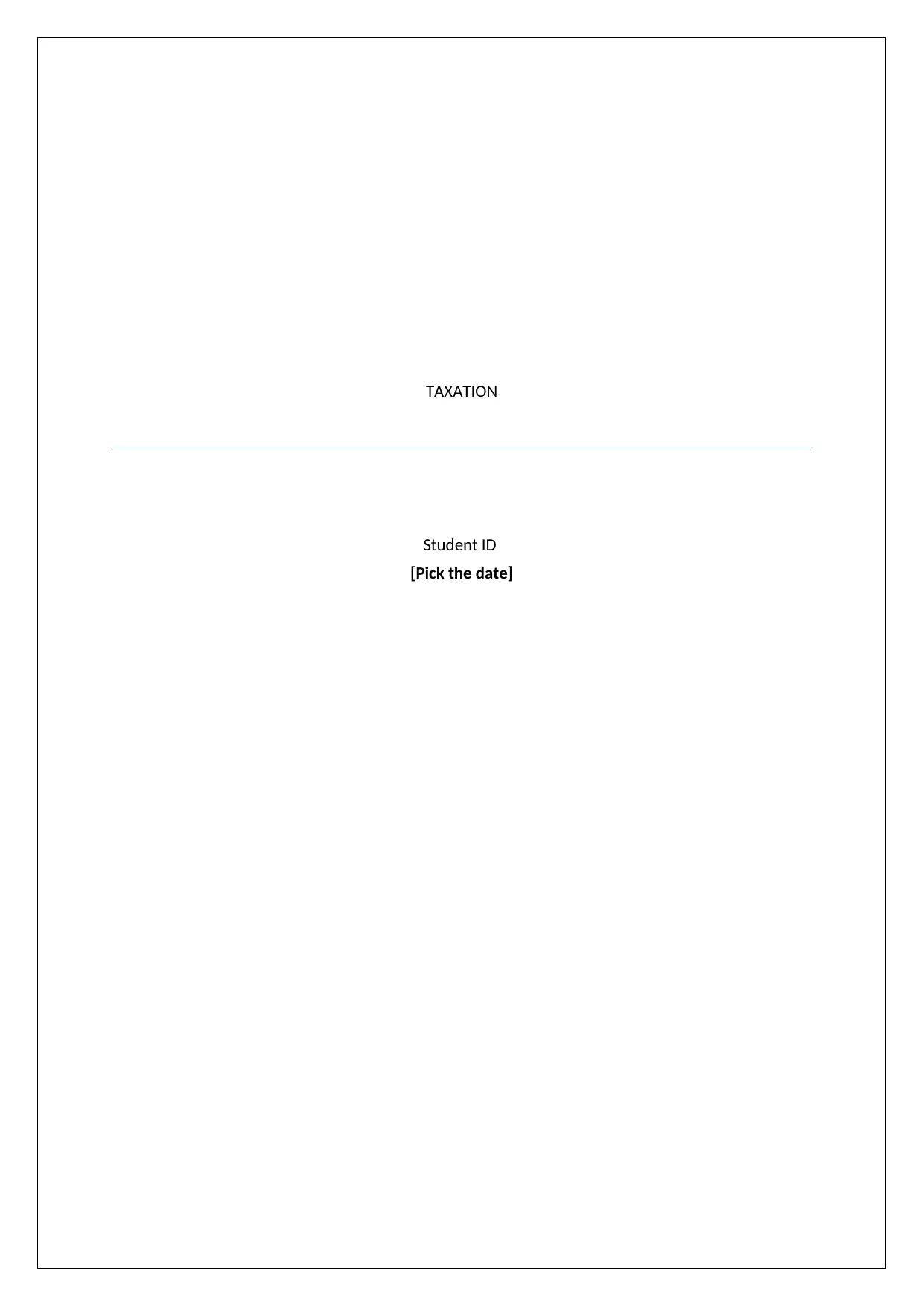
TAXATION
Student ID
[Pick the date]
Student ID
[Pick the date]
Paraphrase This Document
Need a fresh take? Get an instant paraphrase of this document with our AI Paraphraser
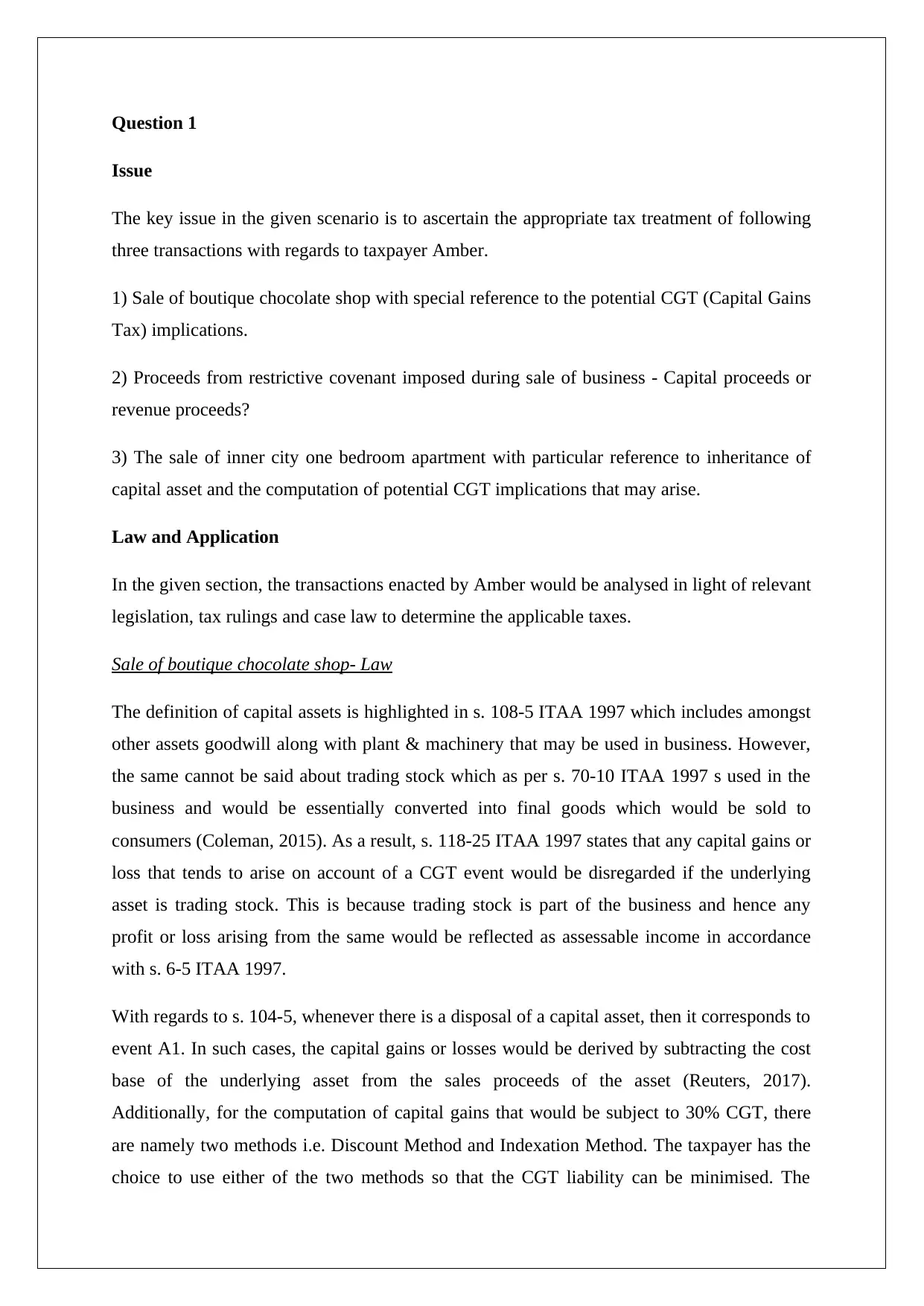
Question 1
Issue
The key issue in the given scenario is to ascertain the appropriate tax treatment of following
three transactions with regards to taxpayer Amber.
1) Sale of boutique chocolate shop with special reference to the potential CGT (Capital Gains
Tax) implications.
2) Proceeds from restrictive covenant imposed during sale of business - Capital proceeds or
revenue proceeds?
3) The sale of inner city one bedroom apartment with particular reference to inheritance of
capital asset and the computation of potential CGT implications that may arise.
Law and Application
In the given section, the transactions enacted by Amber would be analysed in light of relevant
legislation, tax rulings and case law to determine the applicable taxes.
Sale of boutique chocolate shop- Law
The definition of capital assets is highlighted in s. 108-5 ITAA 1997 which includes amongst
other assets goodwill along with plant & machinery that may be used in business. However,
the same cannot be said about trading stock which as per s. 70-10 ITAA 1997 s used in the
business and would be essentially converted into final goods which would be sold to
consumers (Coleman, 2015). As a result, s. 118-25 ITAA 1997 states that any capital gains or
loss that tends to arise on account of a CGT event would be disregarded if the underlying
asset is trading stock. This is because trading stock is part of the business and hence any
profit or loss arising from the same would be reflected as assessable income in accordance
with s. 6-5 ITAA 1997.
With regards to s. 104-5, whenever there is a disposal of a capital asset, then it corresponds to
event A1. In such cases, the capital gains or losses would be derived by subtracting the cost
base of the underlying asset from the sales proceeds of the asset (Reuters, 2017).
Additionally, for the computation of capital gains that would be subject to 30% CGT, there
are namely two methods i.e. Discount Method and Indexation Method. The taxpayer has the
choice to use either of the two methods so that the CGT liability can be minimised. The
Issue
The key issue in the given scenario is to ascertain the appropriate tax treatment of following
three transactions with regards to taxpayer Amber.
1) Sale of boutique chocolate shop with special reference to the potential CGT (Capital Gains
Tax) implications.
2) Proceeds from restrictive covenant imposed during sale of business - Capital proceeds or
revenue proceeds?
3) The sale of inner city one bedroom apartment with particular reference to inheritance of
capital asset and the computation of potential CGT implications that may arise.
Law and Application
In the given section, the transactions enacted by Amber would be analysed in light of relevant
legislation, tax rulings and case law to determine the applicable taxes.
Sale of boutique chocolate shop- Law
The definition of capital assets is highlighted in s. 108-5 ITAA 1997 which includes amongst
other assets goodwill along with plant & machinery that may be used in business. However,
the same cannot be said about trading stock which as per s. 70-10 ITAA 1997 s used in the
business and would be essentially converted into final goods which would be sold to
consumers (Coleman, 2015). As a result, s. 118-25 ITAA 1997 states that any capital gains or
loss that tends to arise on account of a CGT event would be disregarded if the underlying
asset is trading stock. This is because trading stock is part of the business and hence any
profit or loss arising from the same would be reflected as assessable income in accordance
with s. 6-5 ITAA 1997.
With regards to s. 104-5, whenever there is a disposal of a capital asset, then it corresponds to
event A1. In such cases, the capital gains or losses would be derived by subtracting the cost
base of the underlying asset from the sales proceeds of the asset (Reuters, 2017).
Additionally, for the computation of capital gains that would be subject to 30% CGT, there
are namely two methods i.e. Discount Method and Indexation Method. The taxpayer has the
choice to use either of the two methods so that the CGT liability can be minimised. The
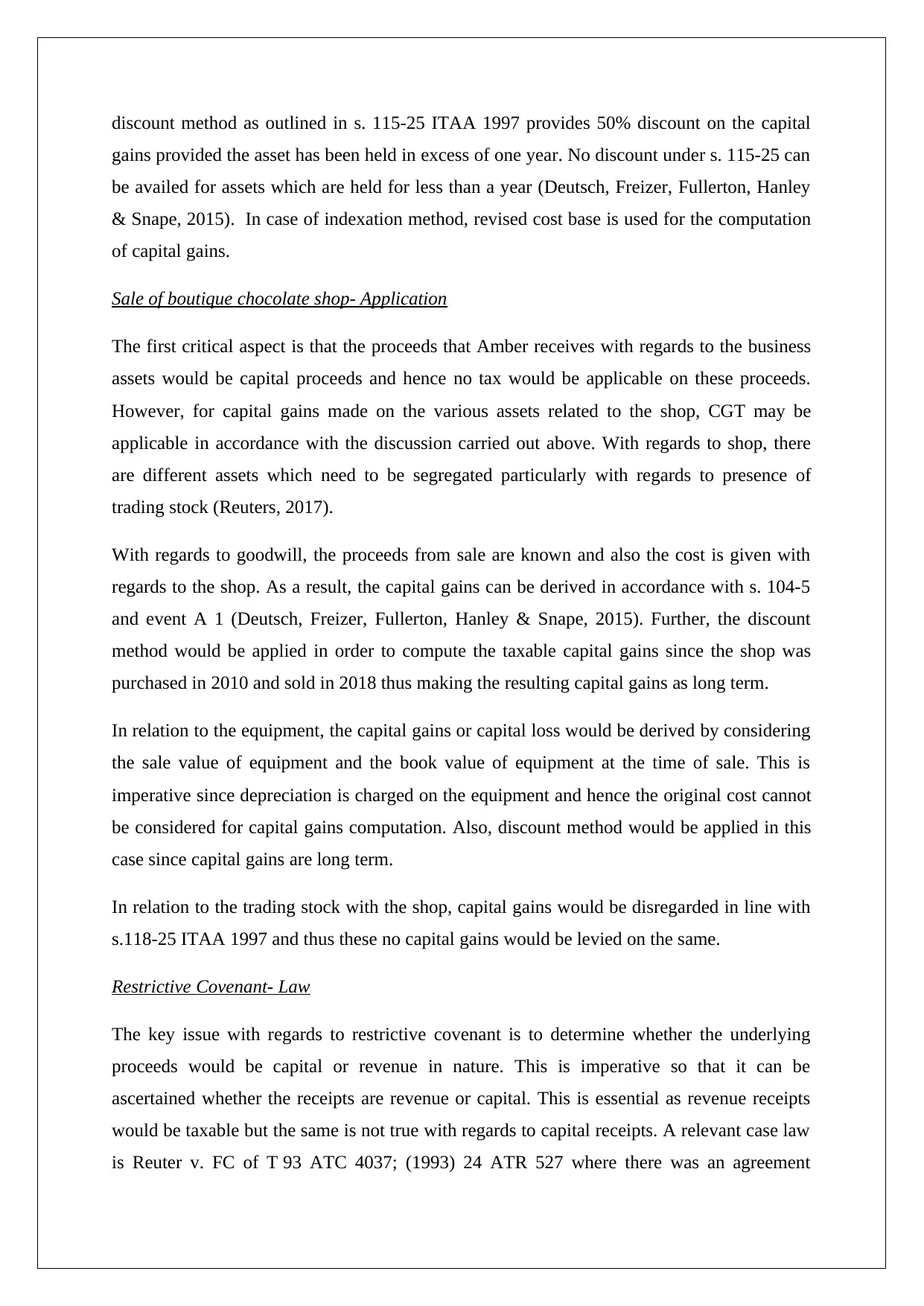
discount method as outlined in s. 115-25 ITAA 1997 provides 50% discount on the capital
gains provided the asset has been held in excess of one year. No discount under s. 115-25 can
be availed for assets which are held for less than a year (Deutsch, Freizer, Fullerton, Hanley
& Snape, 2015). In case of indexation method, revised cost base is used for the computation
of capital gains.
Sale of boutique chocolate shop- Application
The first critical aspect is that the proceeds that Amber receives with regards to the business
assets would be capital proceeds and hence no tax would be applicable on these proceeds.
However, for capital gains made on the various assets related to the shop, CGT may be
applicable in accordance with the discussion carried out above. With regards to shop, there
are different assets which need to be segregated particularly with regards to presence of
trading stock (Reuters, 2017).
With regards to goodwill, the proceeds from sale are known and also the cost is given with
regards to the shop. As a result, the capital gains can be derived in accordance with s. 104-5
and event A 1 (Deutsch, Freizer, Fullerton, Hanley & Snape, 2015). Further, the discount
method would be applied in order to compute the taxable capital gains since the shop was
purchased in 2010 and sold in 2018 thus making the resulting capital gains as long term.
In relation to the equipment, the capital gains or capital loss would be derived by considering
the sale value of equipment and the book value of equipment at the time of sale. This is
imperative since depreciation is charged on the equipment and hence the original cost cannot
be considered for capital gains computation. Also, discount method would be applied in this
case since capital gains are long term.
In relation to the trading stock with the shop, capital gains would be disregarded in line with
s.118-25 ITAA 1997 and thus these no capital gains would be levied on the same.
Restrictive Covenant- Law
The key issue with regards to restrictive covenant is to determine whether the underlying
proceeds would be capital or revenue in nature. This is imperative so that it can be
ascertained whether the receipts are revenue or capital. This is essential as revenue receipts
would be taxable but the same is not true with regards to capital receipts. A relevant case law
is Reuter v. FC of T 93 ATC 4037; (1993) 24 ATR 527 where there was an agreement
gains provided the asset has been held in excess of one year. No discount under s. 115-25 can
be availed for assets which are held for less than a year (Deutsch, Freizer, Fullerton, Hanley
& Snape, 2015). In case of indexation method, revised cost base is used for the computation
of capital gains.
Sale of boutique chocolate shop- Application
The first critical aspect is that the proceeds that Amber receives with regards to the business
assets would be capital proceeds and hence no tax would be applicable on these proceeds.
However, for capital gains made on the various assets related to the shop, CGT may be
applicable in accordance with the discussion carried out above. With regards to shop, there
are different assets which need to be segregated particularly with regards to presence of
trading stock (Reuters, 2017).
With regards to goodwill, the proceeds from sale are known and also the cost is given with
regards to the shop. As a result, the capital gains can be derived in accordance with s. 104-5
and event A 1 (Deutsch, Freizer, Fullerton, Hanley & Snape, 2015). Further, the discount
method would be applied in order to compute the taxable capital gains since the shop was
purchased in 2010 and sold in 2018 thus making the resulting capital gains as long term.
In relation to the equipment, the capital gains or capital loss would be derived by considering
the sale value of equipment and the book value of equipment at the time of sale. This is
imperative since depreciation is charged on the equipment and hence the original cost cannot
be considered for capital gains computation. Also, discount method would be applied in this
case since capital gains are long term.
In relation to the trading stock with the shop, capital gains would be disregarded in line with
s.118-25 ITAA 1997 and thus these no capital gains would be levied on the same.
Restrictive Covenant- Law
The key issue with regards to restrictive covenant is to determine whether the underlying
proceeds would be capital or revenue in nature. This is imperative so that it can be
ascertained whether the receipts are revenue or capital. This is essential as revenue receipts
would be taxable but the same is not true with regards to capital receipts. A relevant case law
is Reuter v. FC of T 93 ATC 4037; (1993) 24 ATR 527 where there was an agreement
⊘ This is a preview!⊘
Do you want full access?
Subscribe today to unlock all pages.

Trusted by 1+ million students worldwide
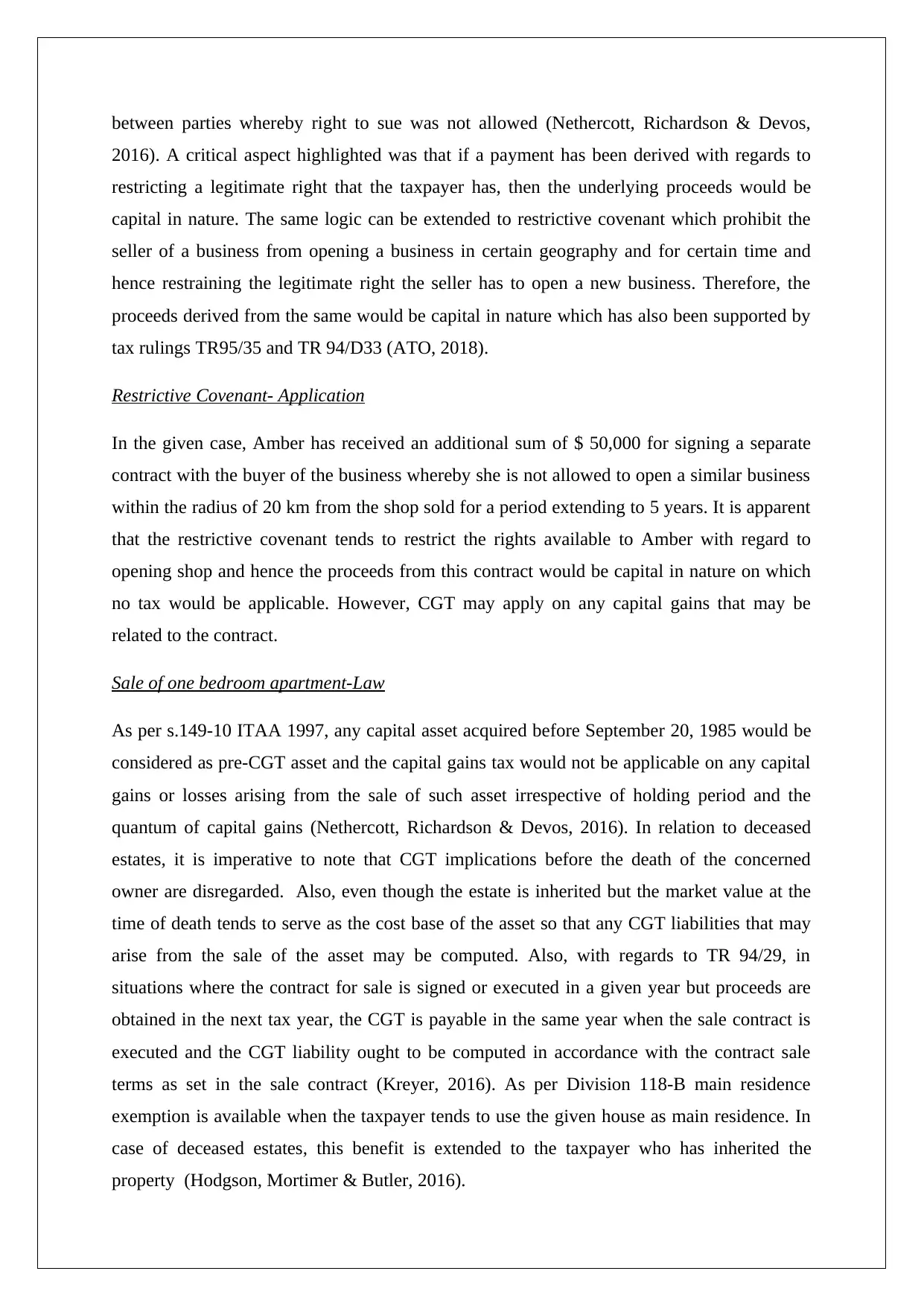
between parties whereby right to sue was not allowed (Nethercott, Richardson & Devos,
2016). A critical aspect highlighted was that if a payment has been derived with regards to
restricting a legitimate right that the taxpayer has, then the underlying proceeds would be
capital in nature. The same logic can be extended to restrictive covenant which prohibit the
seller of a business from opening a business in certain geography and for certain time and
hence restraining the legitimate right the seller has to open a new business. Therefore, the
proceeds derived from the same would be capital in nature which has also been supported by
tax rulings TR95/35 and TR 94/D33 (ATO, 2018).
Restrictive Covenant- Application
In the given case, Amber has received an additional sum of $ 50,000 for signing a separate
contract with the buyer of the business whereby she is not allowed to open a similar business
within the radius of 20 km from the shop sold for a period extending to 5 years. It is apparent
that the restrictive covenant tends to restrict the rights available to Amber with regard to
opening shop and hence the proceeds from this contract would be capital in nature on which
no tax would be applicable. However, CGT may apply on any capital gains that may be
related to the contract.
Sale of one bedroom apartment-Law
As per s.149-10 ITAA 1997, any capital asset acquired before September 20, 1985 would be
considered as pre-CGT asset and the capital gains tax would not be applicable on any capital
gains or losses arising from the sale of such asset irrespective of holding period and the
quantum of capital gains (Nethercott, Richardson & Devos, 2016). In relation to deceased
estates, it is imperative to note that CGT implications before the death of the concerned
owner are disregarded. Also, even though the estate is inherited but the market value at the
time of death tends to serve as the cost base of the asset so that any CGT liabilities that may
arise from the sale of the asset may be computed. Also, with regards to TR 94/29, in
situations where the contract for sale is signed or executed in a given year but proceeds are
obtained in the next tax year, the CGT is payable in the same year when the sale contract is
executed and the CGT liability ought to be computed in accordance with the contract sale
terms as set in the sale contract (Kreyer, 2016). As per Division 118-B main residence
exemption is available when the taxpayer tends to use the given house as main residence. In
case of deceased estates, this benefit is extended to the taxpayer who has inherited the
property (Hodgson, Mortimer & Butler, 2016).
2016). A critical aspect highlighted was that if a payment has been derived with regards to
restricting a legitimate right that the taxpayer has, then the underlying proceeds would be
capital in nature. The same logic can be extended to restrictive covenant which prohibit the
seller of a business from opening a business in certain geography and for certain time and
hence restraining the legitimate right the seller has to open a new business. Therefore, the
proceeds derived from the same would be capital in nature which has also been supported by
tax rulings TR95/35 and TR 94/D33 (ATO, 2018).
Restrictive Covenant- Application
In the given case, Amber has received an additional sum of $ 50,000 for signing a separate
contract with the buyer of the business whereby she is not allowed to open a similar business
within the radius of 20 km from the shop sold for a period extending to 5 years. It is apparent
that the restrictive covenant tends to restrict the rights available to Amber with regard to
opening shop and hence the proceeds from this contract would be capital in nature on which
no tax would be applicable. However, CGT may apply on any capital gains that may be
related to the contract.
Sale of one bedroom apartment-Law
As per s.149-10 ITAA 1997, any capital asset acquired before September 20, 1985 would be
considered as pre-CGT asset and the capital gains tax would not be applicable on any capital
gains or losses arising from the sale of such asset irrespective of holding period and the
quantum of capital gains (Nethercott, Richardson & Devos, 2016). In relation to deceased
estates, it is imperative to note that CGT implications before the death of the concerned
owner are disregarded. Also, even though the estate is inherited but the market value at the
time of death tends to serve as the cost base of the asset so that any CGT liabilities that may
arise from the sale of the asset may be computed. Also, with regards to TR 94/29, in
situations where the contract for sale is signed or executed in a given year but proceeds are
obtained in the next tax year, the CGT is payable in the same year when the sale contract is
executed and the CGT liability ought to be computed in accordance with the contract sale
terms as set in the sale contract (Kreyer, 2016). As per Division 118-B main residence
exemption is available when the taxpayer tends to use the given house as main residence. In
case of deceased estates, this benefit is extended to the taxpayer who has inherited the
property (Hodgson, Mortimer & Butler, 2016).
Paraphrase This Document
Need a fresh take? Get an instant paraphrase of this document with our AI Paraphraser
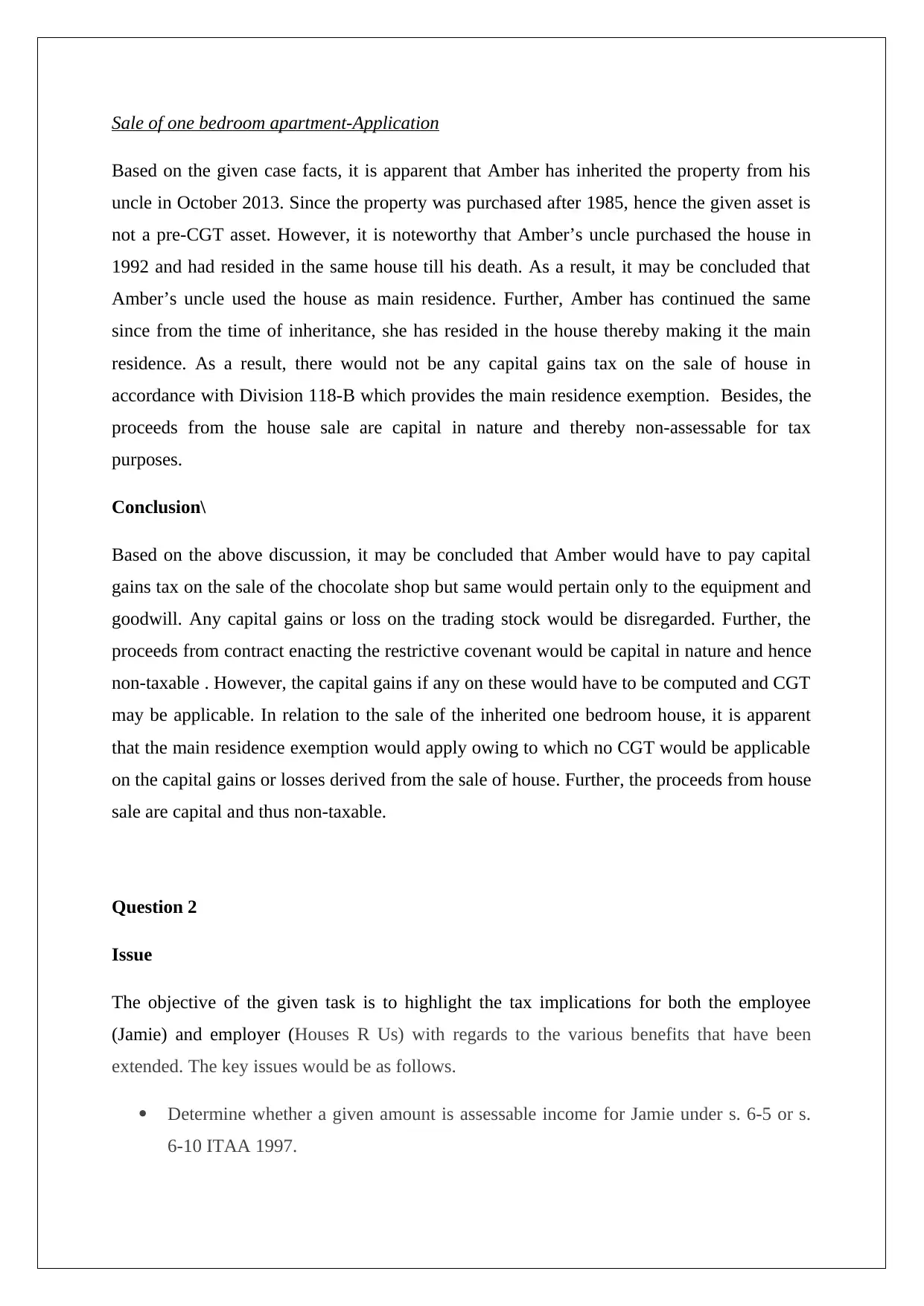
Sale of one bedroom apartment-Application
Based on the given case facts, it is apparent that Amber has inherited the property from his
uncle in October 2013. Since the property was purchased after 1985, hence the given asset is
not a pre-CGT asset. However, it is noteworthy that Amber’s uncle purchased the house in
1992 and had resided in the same house till his death. As a result, it may be concluded that
Amber’s uncle used the house as main residence. Further, Amber has continued the same
since from the time of inheritance, she has resided in the house thereby making it the main
residence. As a result, there would not be any capital gains tax on the sale of house in
accordance with Division 118-B which provides the main residence exemption. Besides, the
proceeds from the house sale are capital in nature and thereby non-assessable for tax
purposes.
Conclusion\
Based on the above discussion, it may be concluded that Amber would have to pay capital
gains tax on the sale of the chocolate shop but same would pertain only to the equipment and
goodwill. Any capital gains or loss on the trading stock would be disregarded. Further, the
proceeds from contract enacting the restrictive covenant would be capital in nature and hence
non-taxable . However, the capital gains if any on these would have to be computed and CGT
may be applicable. In relation to the sale of the inherited one bedroom house, it is apparent
that the main residence exemption would apply owing to which no CGT would be applicable
on the capital gains or losses derived from the sale of house. Further, the proceeds from house
sale are capital and thus non-taxable.
Question 2
Issue
The objective of the given task is to highlight the tax implications for both the employee
(Jamie) and employer (Houses R Us) with regards to the various benefits that have been
extended. The key issues would be as follows.
Determine whether a given amount is assessable income for Jamie under s. 6-5 or s.
6-10 ITAA 1997.
Based on the given case facts, it is apparent that Amber has inherited the property from his
uncle in October 2013. Since the property was purchased after 1985, hence the given asset is
not a pre-CGT asset. However, it is noteworthy that Amber’s uncle purchased the house in
1992 and had resided in the same house till his death. As a result, it may be concluded that
Amber’s uncle used the house as main residence. Further, Amber has continued the same
since from the time of inheritance, she has resided in the house thereby making it the main
residence. As a result, there would not be any capital gains tax on the sale of house in
accordance with Division 118-B which provides the main residence exemption. Besides, the
proceeds from the house sale are capital in nature and thereby non-assessable for tax
purposes.
Conclusion\
Based on the above discussion, it may be concluded that Amber would have to pay capital
gains tax on the sale of the chocolate shop but same would pertain only to the equipment and
goodwill. Any capital gains or loss on the trading stock would be disregarded. Further, the
proceeds from contract enacting the restrictive covenant would be capital in nature and hence
non-taxable . However, the capital gains if any on these would have to be computed and CGT
may be applicable. In relation to the sale of the inherited one bedroom house, it is apparent
that the main residence exemption would apply owing to which no CGT would be applicable
on the capital gains or losses derived from the sale of house. Further, the proceeds from house
sale are capital and thus non-taxable.
Question 2
Issue
The objective of the given task is to highlight the tax implications for both the employee
(Jamie) and employer (Houses R Us) with regards to the various benefits that have been
extended. The key issues would be as follows.
Determine whether a given amount is assessable income for Jamie under s. 6-5 or s.
6-10 ITAA 1997.
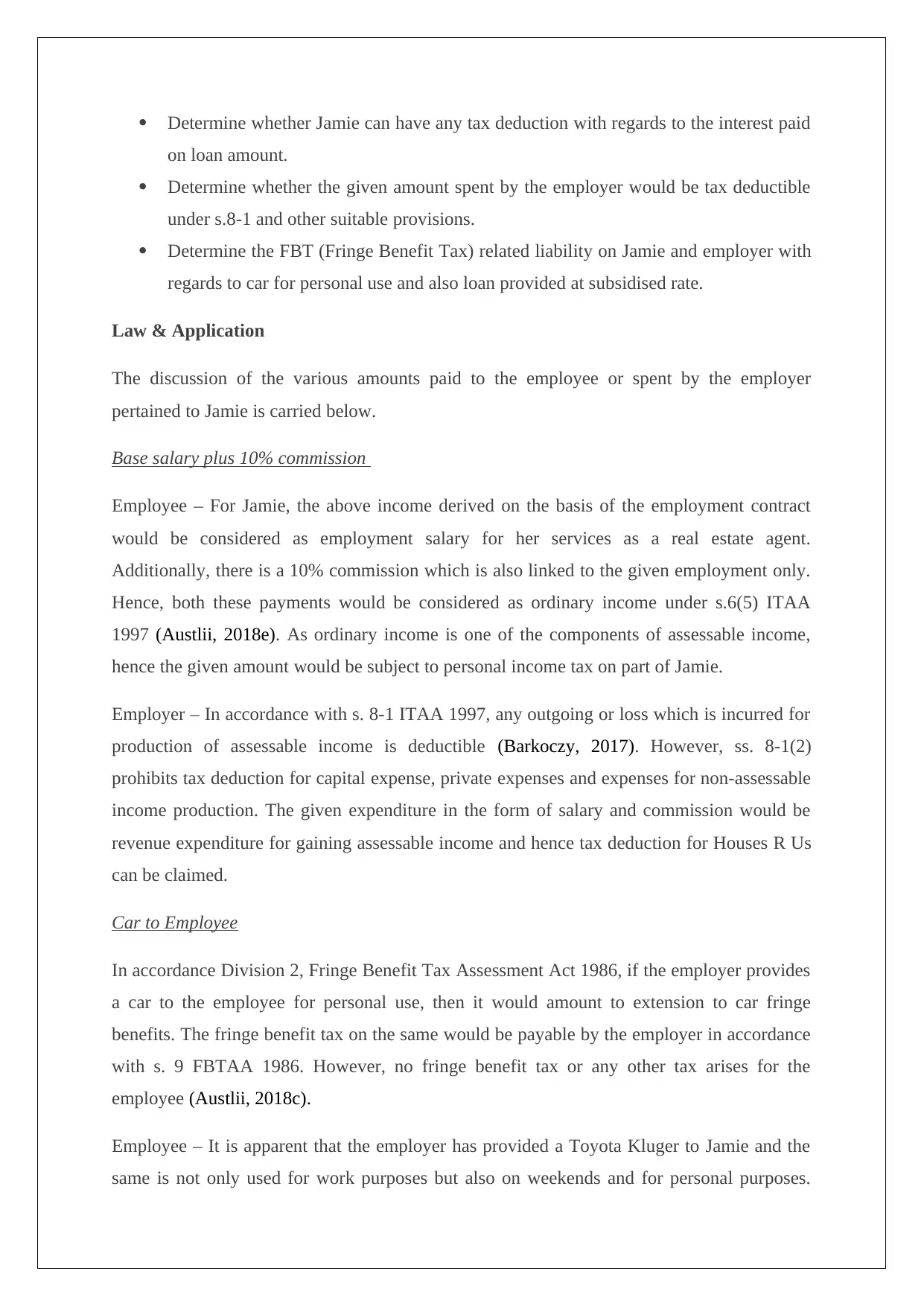
Determine whether Jamie can have any tax deduction with regards to the interest paid
on loan amount.
Determine whether the given amount spent by the employer would be tax deductible
under s.8-1 and other suitable provisions.
Determine the FBT (Fringe Benefit Tax) related liability on Jamie and employer with
regards to car for personal use and also loan provided at subsidised rate.
Law & Application
The discussion of the various amounts paid to the employee or spent by the employer
pertained to Jamie is carried below.
Base salary plus 10% commission
Employee – For Jamie, the above income derived on the basis of the employment contract
would be considered as employment salary for her services as a real estate agent.
Additionally, there is a 10% commission which is also linked to the given employment only.
Hence, both these payments would be considered as ordinary income under s.6(5) ITAA
1997 (Austlii, 2018e). As ordinary income is one of the components of assessable income,
hence the given amount would be subject to personal income tax on part of Jamie.
Employer – In accordance with s. 8-1 ITAA 1997, any outgoing or loss which is incurred for
production of assessable income is deductible (Barkoczy, 2017). However, ss. 8-1(2)
prohibits tax deduction for capital expense, private expenses and expenses for non-assessable
income production. The given expenditure in the form of salary and commission would be
revenue expenditure for gaining assessable income and hence tax deduction for Houses R Us
can be claimed.
Car to Employee
In accordance Division 2, Fringe Benefit Tax Assessment Act 1986, if the employer provides
a car to the employee for personal use, then it would amount to extension to car fringe
benefits. The fringe benefit tax on the same would be payable by the employer in accordance
with s. 9 FBTAA 1986. However, no fringe benefit tax or any other tax arises for the
employee (Austlii, 2018c).
Employee – It is apparent that the employer has provided a Toyota Kluger to Jamie and the
same is not only used for work purposes but also on weekends and for personal purposes.
on loan amount.
Determine whether the given amount spent by the employer would be tax deductible
under s.8-1 and other suitable provisions.
Determine the FBT (Fringe Benefit Tax) related liability on Jamie and employer with
regards to car for personal use and also loan provided at subsidised rate.
Law & Application
The discussion of the various amounts paid to the employee or spent by the employer
pertained to Jamie is carried below.
Base salary plus 10% commission
Employee – For Jamie, the above income derived on the basis of the employment contract
would be considered as employment salary for her services as a real estate agent.
Additionally, there is a 10% commission which is also linked to the given employment only.
Hence, both these payments would be considered as ordinary income under s.6(5) ITAA
1997 (Austlii, 2018e). As ordinary income is one of the components of assessable income,
hence the given amount would be subject to personal income tax on part of Jamie.
Employer – In accordance with s. 8-1 ITAA 1997, any outgoing or loss which is incurred for
production of assessable income is deductible (Barkoczy, 2017). However, ss. 8-1(2)
prohibits tax deduction for capital expense, private expenses and expenses for non-assessable
income production. The given expenditure in the form of salary and commission would be
revenue expenditure for gaining assessable income and hence tax deduction for Houses R Us
can be claimed.
Car to Employee
In accordance Division 2, Fringe Benefit Tax Assessment Act 1986, if the employer provides
a car to the employee for personal use, then it would amount to extension to car fringe
benefits. The fringe benefit tax on the same would be payable by the employer in accordance
with s. 9 FBTAA 1986. However, no fringe benefit tax or any other tax arises for the
employee (Austlii, 2018c).
Employee – It is apparent that the employer has provided a Toyota Kluger to Jamie and the
same is not only used for work purposes but also on weekends and for personal purposes.
⊘ This is a preview!⊘
Do you want full access?
Subscribe today to unlock all pages.

Trusted by 1+ million students worldwide
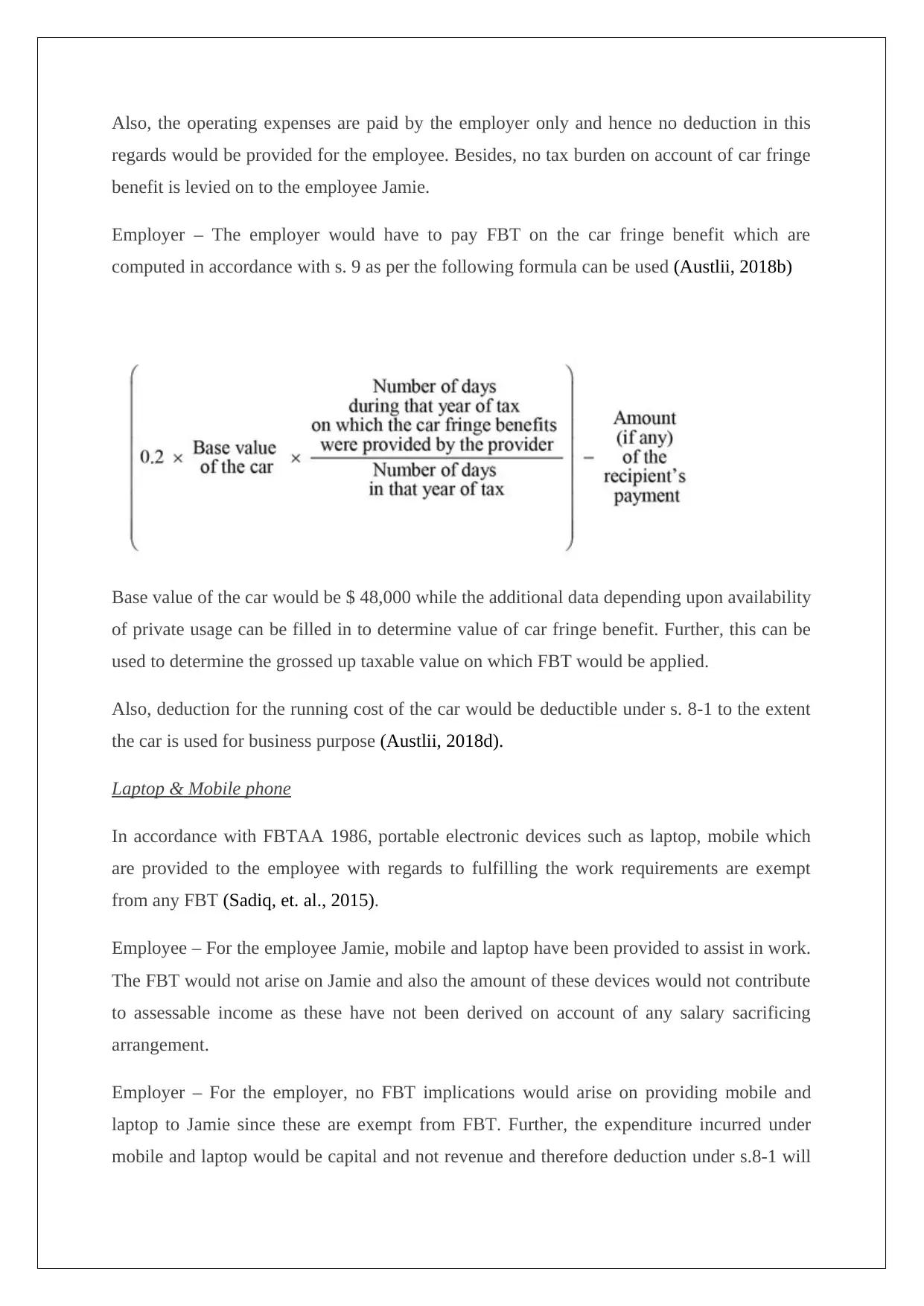
Also, the operating expenses are paid by the employer only and hence no deduction in this
regards would be provided for the employee. Besides, no tax burden on account of car fringe
benefit is levied on to the employee Jamie.
Employer – The employer would have to pay FBT on the car fringe benefit which are
computed in accordance with s. 9 as per the following formula can be used (Austlii, 2018b)
Base value of the car would be $ 48,000 while the additional data depending upon availability
of private usage can be filled in to determine value of car fringe benefit. Further, this can be
used to determine the grossed up taxable value on which FBT would be applied.
Also, deduction for the running cost of the car would be deductible under s. 8-1 to the extent
the car is used for business purpose (Austlii, 2018d).
Laptop & Mobile phone
In accordance with FBTAA 1986, portable electronic devices such as laptop, mobile which
are provided to the employee with regards to fulfilling the work requirements are exempt
from any FBT (Sadiq, et. al., 2015).
Employee – For the employee Jamie, mobile and laptop have been provided to assist in work.
The FBT would not arise on Jamie and also the amount of these devices would not contribute
to assessable income as these have not been derived on account of any salary sacrificing
arrangement.
Employer – For the employer, no FBT implications would arise on providing mobile and
laptop to Jamie since these are exempt from FBT. Further, the expenditure incurred under
mobile and laptop would be capital and not revenue and therefore deduction under s.8-1 will
regards would be provided for the employee. Besides, no tax burden on account of car fringe
benefit is levied on to the employee Jamie.
Employer – The employer would have to pay FBT on the car fringe benefit which are
computed in accordance with s. 9 as per the following formula can be used (Austlii, 2018b)
Base value of the car would be $ 48,000 while the additional data depending upon availability
of private usage can be filled in to determine value of car fringe benefit. Further, this can be
used to determine the grossed up taxable value on which FBT would be applied.
Also, deduction for the running cost of the car would be deductible under s. 8-1 to the extent
the car is used for business purpose (Austlii, 2018d).
Laptop & Mobile phone
In accordance with FBTAA 1986, portable electronic devices such as laptop, mobile which
are provided to the employee with regards to fulfilling the work requirements are exempt
from any FBT (Sadiq, et. al., 2015).
Employee – For the employee Jamie, mobile and laptop have been provided to assist in work.
The FBT would not arise on Jamie and also the amount of these devices would not contribute
to assessable income as these have not been derived on account of any salary sacrificing
arrangement.
Employer – For the employer, no FBT implications would arise on providing mobile and
laptop to Jamie since these are exempt from FBT. Further, the expenditure incurred under
mobile and laptop would be capital and not revenue and therefore deduction under s.8-1 will
Paraphrase This Document
Need a fresh take? Get an instant paraphrase of this document with our AI Paraphraser
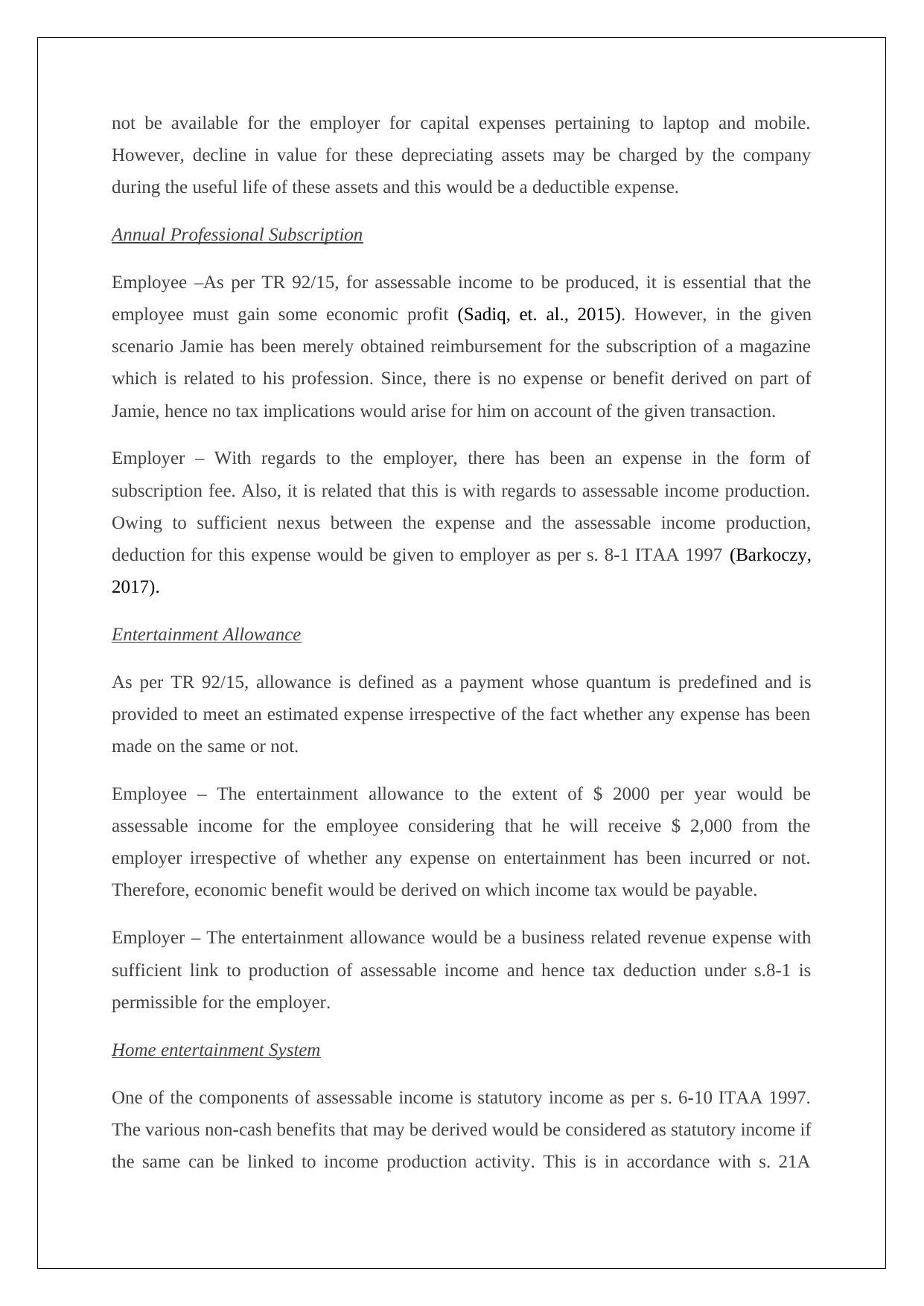
not be available for the employer for capital expenses pertaining to laptop and mobile.
However, decline in value for these depreciating assets may be charged by the company
during the useful life of these assets and this would be a deductible expense.
Annual Professional Subscription
Employee –As per TR 92/15, for assessable income to be produced, it is essential that the
employee must gain some economic profit (Sadiq, et. al., 2015). However, in the given
scenario Jamie has been merely obtained reimbursement for the subscription of a magazine
which is related to his profession. Since, there is no expense or benefit derived on part of
Jamie, hence no tax implications would arise for him on account of the given transaction.
Employer – With regards to the employer, there has been an expense in the form of
subscription fee. Also, it is related that this is with regards to assessable income production.
Owing to sufficient nexus between the expense and the assessable income production,
deduction for this expense would be given to employer as per s. 8-1 ITAA 1997 (Barkoczy,
2017).
Entertainment Allowance
As per TR 92/15, allowance is defined as a payment whose quantum is predefined and is
provided to meet an estimated expense irrespective of the fact whether any expense has been
made on the same or not.
Employee – The entertainment allowance to the extent of $ 2000 per year would be
assessable income for the employee considering that he will receive $ 2,000 from the
employer irrespective of whether any expense on entertainment has been incurred or not.
Therefore, economic benefit would be derived on which income tax would be payable.
Employer – The entertainment allowance would be a business related revenue expense with
sufficient link to production of assessable income and hence tax deduction under s.8-1 is
permissible for the employer.
Home entertainment System
One of the components of assessable income is statutory income as per s. 6-10 ITAA 1997.
The various non-cash benefits that may be derived would be considered as statutory income if
the same can be linked to income production activity. This is in accordance with s. 21A
However, decline in value for these depreciating assets may be charged by the company
during the useful life of these assets and this would be a deductible expense.
Annual Professional Subscription
Employee –As per TR 92/15, for assessable income to be produced, it is essential that the
employee must gain some economic profit (Sadiq, et. al., 2015). However, in the given
scenario Jamie has been merely obtained reimbursement for the subscription of a magazine
which is related to his profession. Since, there is no expense or benefit derived on part of
Jamie, hence no tax implications would arise for him on account of the given transaction.
Employer – With regards to the employer, there has been an expense in the form of
subscription fee. Also, it is related that this is with regards to assessable income production.
Owing to sufficient nexus between the expense and the assessable income production,
deduction for this expense would be given to employer as per s. 8-1 ITAA 1997 (Barkoczy,
2017).
Entertainment Allowance
As per TR 92/15, allowance is defined as a payment whose quantum is predefined and is
provided to meet an estimated expense irrespective of the fact whether any expense has been
made on the same or not.
Employee – The entertainment allowance to the extent of $ 2000 per year would be
assessable income for the employee considering that he will receive $ 2,000 from the
employer irrespective of whether any expense on entertainment has been incurred or not.
Therefore, economic benefit would be derived on which income tax would be payable.
Employer – The entertainment allowance would be a business related revenue expense with
sufficient link to production of assessable income and hence tax deduction under s.8-1 is
permissible for the employer.
Home entertainment System
One of the components of assessable income is statutory income as per s. 6-10 ITAA 1997.
The various non-cash benefits that may be derived would be considered as statutory income if
the same can be linked to income production activity. This is in accordance with s. 21A
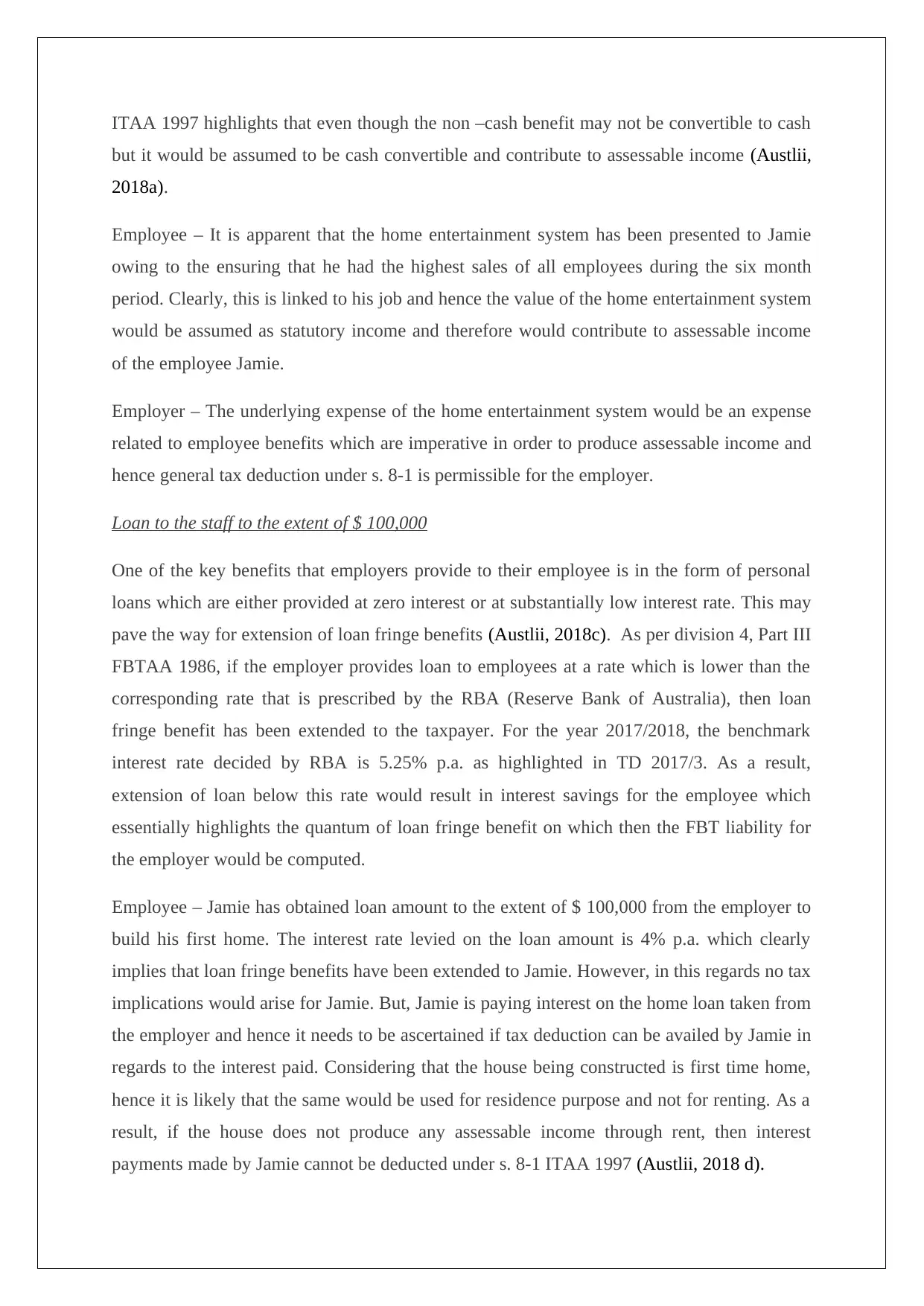
ITAA 1997 highlights that even though the non –cash benefit may not be convertible to cash
but it would be assumed to be cash convertible and contribute to assessable income (Austlii,
2018a).
Employee – It is apparent that the home entertainment system has been presented to Jamie
owing to the ensuring that he had the highest sales of all employees during the six month
period. Clearly, this is linked to his job and hence the value of the home entertainment system
would be assumed as statutory income and therefore would contribute to assessable income
of the employee Jamie.
Employer – The underlying expense of the home entertainment system would be an expense
related to employee benefits which are imperative in order to produce assessable income and
hence general tax deduction under s. 8-1 is permissible for the employer.
Loan to the staff to the extent of $ 100,000
One of the key benefits that employers provide to their employee is in the form of personal
loans which are either provided at zero interest or at substantially low interest rate. This may
pave the way for extension of loan fringe benefits (Austlii, 2018c). As per division 4, Part III
FBTAA 1986, if the employer provides loan to employees at a rate which is lower than the
corresponding rate that is prescribed by the RBA (Reserve Bank of Australia), then loan
fringe benefit has been extended to the taxpayer. For the year 2017/2018, the benchmark
interest rate decided by RBA is 5.25% p.a. as highlighted in TD 2017/3. As a result,
extension of loan below this rate would result in interest savings for the employee which
essentially highlights the quantum of loan fringe benefit on which then the FBT liability for
the employer would be computed.
Employee – Jamie has obtained loan amount to the extent of $ 100,000 from the employer to
build his first home. The interest rate levied on the loan amount is 4% p.a. which clearly
implies that loan fringe benefits have been extended to Jamie. However, in this regards no tax
implications would arise for Jamie. But, Jamie is paying interest on the home loan taken from
the employer and hence it needs to be ascertained if tax deduction can be availed by Jamie in
regards to the interest paid. Considering that the house being constructed is first time home,
hence it is likely that the same would be used for residence purpose and not for renting. As a
result, if the house does not produce any assessable income through rent, then interest
payments made by Jamie cannot be deducted under s. 8-1 ITAA 1997 (Austlii, 2018 d).
but it would be assumed to be cash convertible and contribute to assessable income (Austlii,
2018a).
Employee – It is apparent that the home entertainment system has been presented to Jamie
owing to the ensuring that he had the highest sales of all employees during the six month
period. Clearly, this is linked to his job and hence the value of the home entertainment system
would be assumed as statutory income and therefore would contribute to assessable income
of the employee Jamie.
Employer – The underlying expense of the home entertainment system would be an expense
related to employee benefits which are imperative in order to produce assessable income and
hence general tax deduction under s. 8-1 is permissible for the employer.
Loan to the staff to the extent of $ 100,000
One of the key benefits that employers provide to their employee is in the form of personal
loans which are either provided at zero interest or at substantially low interest rate. This may
pave the way for extension of loan fringe benefits (Austlii, 2018c). As per division 4, Part III
FBTAA 1986, if the employer provides loan to employees at a rate which is lower than the
corresponding rate that is prescribed by the RBA (Reserve Bank of Australia), then loan
fringe benefit has been extended to the taxpayer. For the year 2017/2018, the benchmark
interest rate decided by RBA is 5.25% p.a. as highlighted in TD 2017/3. As a result,
extension of loan below this rate would result in interest savings for the employee which
essentially highlights the quantum of loan fringe benefit on which then the FBT liability for
the employer would be computed.
Employee – Jamie has obtained loan amount to the extent of $ 100,000 from the employer to
build his first home. The interest rate levied on the loan amount is 4% p.a. which clearly
implies that loan fringe benefits have been extended to Jamie. However, in this regards no tax
implications would arise for Jamie. But, Jamie is paying interest on the home loan taken from
the employer and hence it needs to be ascertained if tax deduction can be availed by Jamie in
regards to the interest paid. Considering that the house being constructed is first time home,
hence it is likely that the same would be used for residence purpose and not for renting. As a
result, if the house does not produce any assessable income through rent, then interest
payments made by Jamie cannot be deducted under s. 8-1 ITAA 1997 (Austlii, 2018 d).
⊘ This is a preview!⊘
Do you want full access?
Subscribe today to unlock all pages.

Trusted by 1+ million students worldwide
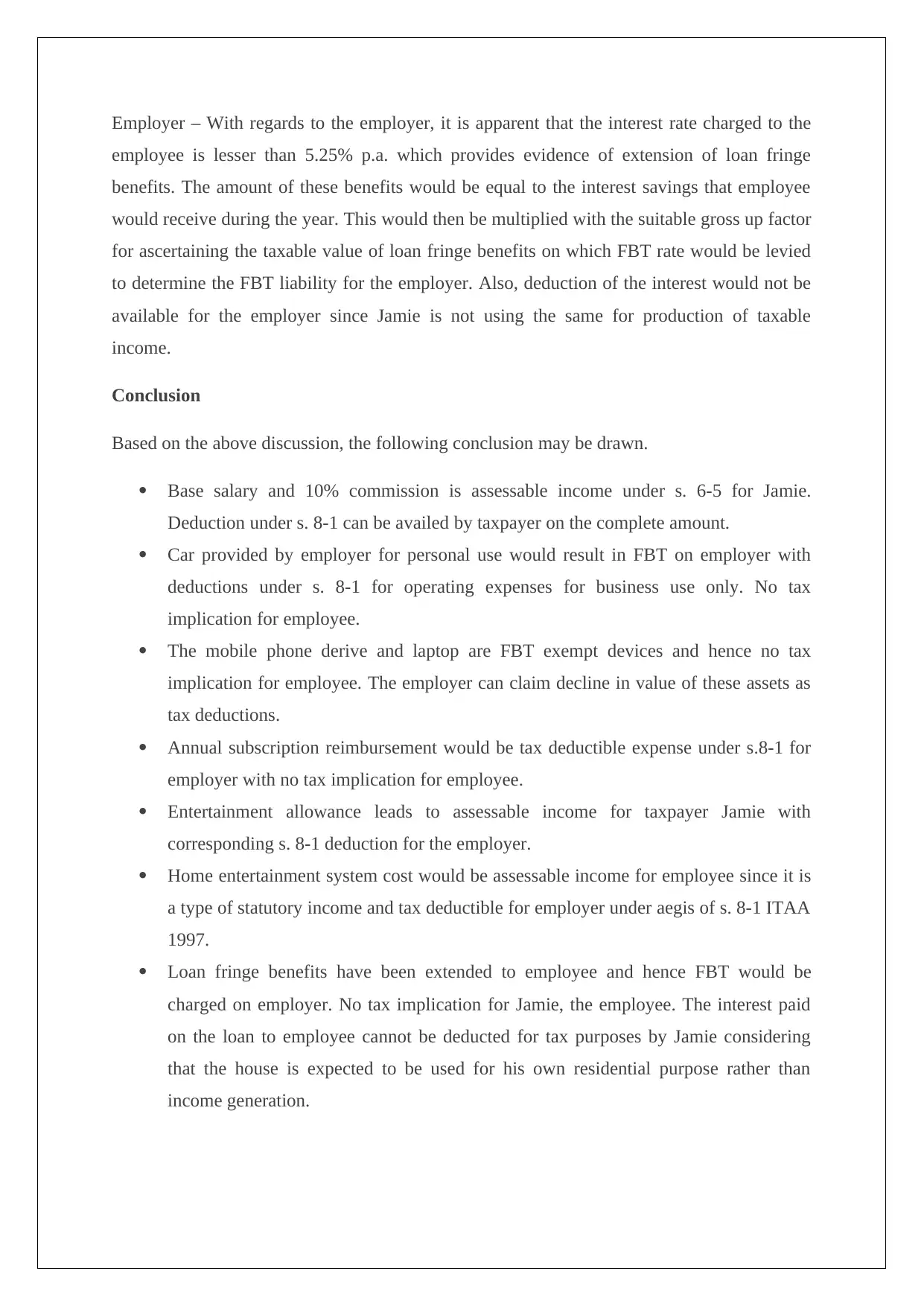
Employer – With regards to the employer, it is apparent that the interest rate charged to the
employee is lesser than 5.25% p.a. which provides evidence of extension of loan fringe
benefits. The amount of these benefits would be equal to the interest savings that employee
would receive during the year. This would then be multiplied with the suitable gross up factor
for ascertaining the taxable value of loan fringe benefits on which FBT rate would be levied
to determine the FBT liability for the employer. Also, deduction of the interest would not be
available for the employer since Jamie is not using the same for production of taxable
income.
Conclusion
Based on the above discussion, the following conclusion may be drawn.
Base salary and 10% commission is assessable income under s. 6-5 for Jamie.
Deduction under s. 8-1 can be availed by taxpayer on the complete amount.
Car provided by employer for personal use would result in FBT on employer with
deductions under s. 8-1 for operating expenses for business use only. No tax
implication for employee.
The mobile phone derive and laptop are FBT exempt devices and hence no tax
implication for employee. The employer can claim decline in value of these assets as
tax deductions.
Annual subscription reimbursement would be tax deductible expense under s.8-1 for
employer with no tax implication for employee.
Entertainment allowance leads to assessable income for taxpayer Jamie with
corresponding s. 8-1 deduction for the employer.
Home entertainment system cost would be assessable income for employee since it is
a type of statutory income and tax deductible for employer under aegis of s. 8-1 ITAA
1997.
Loan fringe benefits have been extended to employee and hence FBT would be
charged on employer. No tax implication for Jamie, the employee. The interest paid
on the loan to employee cannot be deducted for tax purposes by Jamie considering
that the house is expected to be used for his own residential purpose rather than
income generation.
employee is lesser than 5.25% p.a. which provides evidence of extension of loan fringe
benefits. The amount of these benefits would be equal to the interest savings that employee
would receive during the year. This would then be multiplied with the suitable gross up factor
for ascertaining the taxable value of loan fringe benefits on which FBT rate would be levied
to determine the FBT liability for the employer. Also, deduction of the interest would not be
available for the employer since Jamie is not using the same for production of taxable
income.
Conclusion
Based on the above discussion, the following conclusion may be drawn.
Base salary and 10% commission is assessable income under s. 6-5 for Jamie.
Deduction under s. 8-1 can be availed by taxpayer on the complete amount.
Car provided by employer for personal use would result in FBT on employer with
deductions under s. 8-1 for operating expenses for business use only. No tax
implication for employee.
The mobile phone derive and laptop are FBT exempt devices and hence no tax
implication for employee. The employer can claim decline in value of these assets as
tax deductions.
Annual subscription reimbursement would be tax deductible expense under s.8-1 for
employer with no tax implication for employee.
Entertainment allowance leads to assessable income for taxpayer Jamie with
corresponding s. 8-1 deduction for the employer.
Home entertainment system cost would be assessable income for employee since it is
a type of statutory income and tax deductible for employer under aegis of s. 8-1 ITAA
1997.
Loan fringe benefits have been extended to employee and hence FBT would be
charged on employer. No tax implication for Jamie, the employee. The interest paid
on the loan to employee cannot be deducted for tax purposes by Jamie considering
that the house is expected to be used for his own residential purpose rather than
income generation.
Paraphrase This Document
Need a fresh take? Get an instant paraphrase of this document with our AI Paraphraser
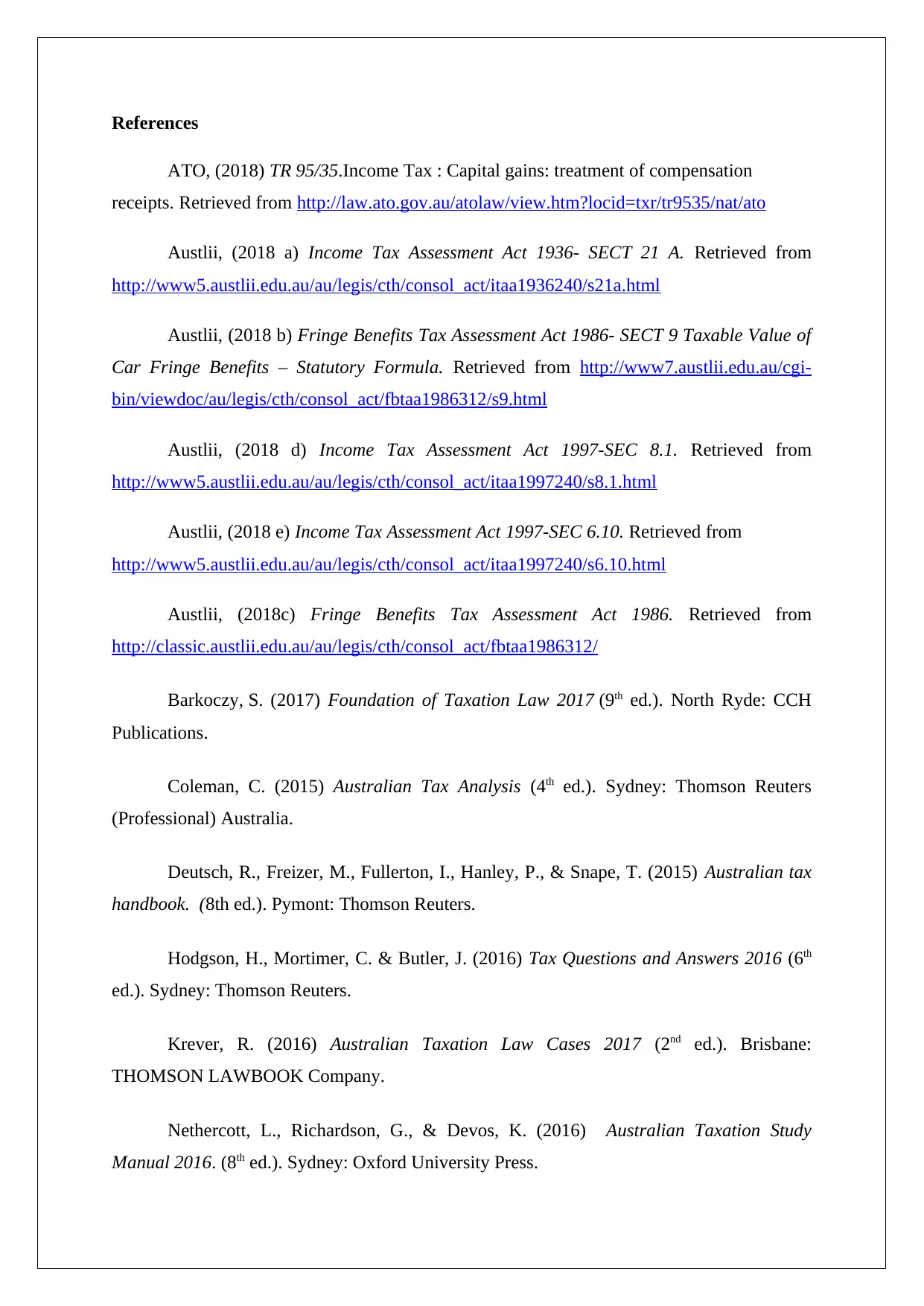
References
ATO, (2018) TR 95/35.Income Tax : Capital gains: treatment of compensation
receipts. Retrieved from http://law.ato.gov.au/atolaw/view.htm?locid=txr/tr9535/nat/ato
Austlii, (2018 a) Income Tax Assessment Act 1936- SECT 21 A. Retrieved from
http://www5.austlii.edu.au/au/legis/cth/consol_act/itaa1936240/s21a.html
Austlii, (2018 b) Fringe Benefits Tax Assessment Act 1986- SECT 9 Taxable Value of
Car Fringe Benefits – Statutory Formula. Retrieved from http://www7.austlii.edu.au/cgi-
bin/viewdoc/au/legis/cth/consol_act/fbtaa1986312/s9.html
Austlii, (2018 d) Income Tax Assessment Act 1997-SEC 8.1. Retrieved from
http://www5.austlii.edu.au/au/legis/cth/consol_act/itaa1997240/s8.1.html
Austlii, (2018 e) Income Tax Assessment Act 1997-SEC 6.10. Retrieved from
http://www5.austlii.edu.au/au/legis/cth/consol_act/itaa1997240/s6.10.html
Austlii, (2018c) Fringe Benefits Tax Assessment Act 1986. Retrieved from
http://classic.austlii.edu.au/au/legis/cth/consol_act/fbtaa1986312/
Barkoczy, S. (2017) Foundation of Taxation Law 2017 (9th ed.). North Ryde: CCH
Publications.
Coleman, C. (2015) Australian Tax Analysis (4th ed.). Sydney: Thomson Reuters
(Professional) Australia.
Deutsch, R., Freizer, M., Fullerton, I., Hanley, P., & Snape, T. (2015) Australian tax
handbook. (8th ed.). Pymont: Thomson Reuters.
Hodgson, H., Mortimer, C. & Butler, J. (2016) Tax Questions and Answers 2016 (6th
ed.). Sydney: Thomson Reuters.
Krever, R. (2016) Australian Taxation Law Cases 2017 (2nd ed.). Brisbane:
THOMSON LAWBOOK Company.
Nethercott, L., Richardson, G., & Devos, K. (2016) Australian Taxation Study
Manual 2016. (8th ed.). Sydney: Oxford University Press.
ATO, (2018) TR 95/35.Income Tax : Capital gains: treatment of compensation
receipts. Retrieved from http://law.ato.gov.au/atolaw/view.htm?locid=txr/tr9535/nat/ato
Austlii, (2018 a) Income Tax Assessment Act 1936- SECT 21 A. Retrieved from
http://www5.austlii.edu.au/au/legis/cth/consol_act/itaa1936240/s21a.html
Austlii, (2018 b) Fringe Benefits Tax Assessment Act 1986- SECT 9 Taxable Value of
Car Fringe Benefits – Statutory Formula. Retrieved from http://www7.austlii.edu.au/cgi-
bin/viewdoc/au/legis/cth/consol_act/fbtaa1986312/s9.html
Austlii, (2018 d) Income Tax Assessment Act 1997-SEC 8.1. Retrieved from
http://www5.austlii.edu.au/au/legis/cth/consol_act/itaa1997240/s8.1.html
Austlii, (2018 e) Income Tax Assessment Act 1997-SEC 6.10. Retrieved from
http://www5.austlii.edu.au/au/legis/cth/consol_act/itaa1997240/s6.10.html
Austlii, (2018c) Fringe Benefits Tax Assessment Act 1986. Retrieved from
http://classic.austlii.edu.au/au/legis/cth/consol_act/fbtaa1986312/
Barkoczy, S. (2017) Foundation of Taxation Law 2017 (9th ed.). North Ryde: CCH
Publications.
Coleman, C. (2015) Australian Tax Analysis (4th ed.). Sydney: Thomson Reuters
(Professional) Australia.
Deutsch, R., Freizer, M., Fullerton, I., Hanley, P., & Snape, T. (2015) Australian tax
handbook. (8th ed.). Pymont: Thomson Reuters.
Hodgson, H., Mortimer, C. & Butler, J. (2016) Tax Questions and Answers 2016 (6th
ed.). Sydney: Thomson Reuters.
Krever, R. (2016) Australian Taxation Law Cases 2017 (2nd ed.). Brisbane:
THOMSON LAWBOOK Company.
Nethercott, L., Richardson, G., & Devos, K. (2016) Australian Taxation Study
Manual 2016. (8th ed.). Sydney: Oxford University Press.
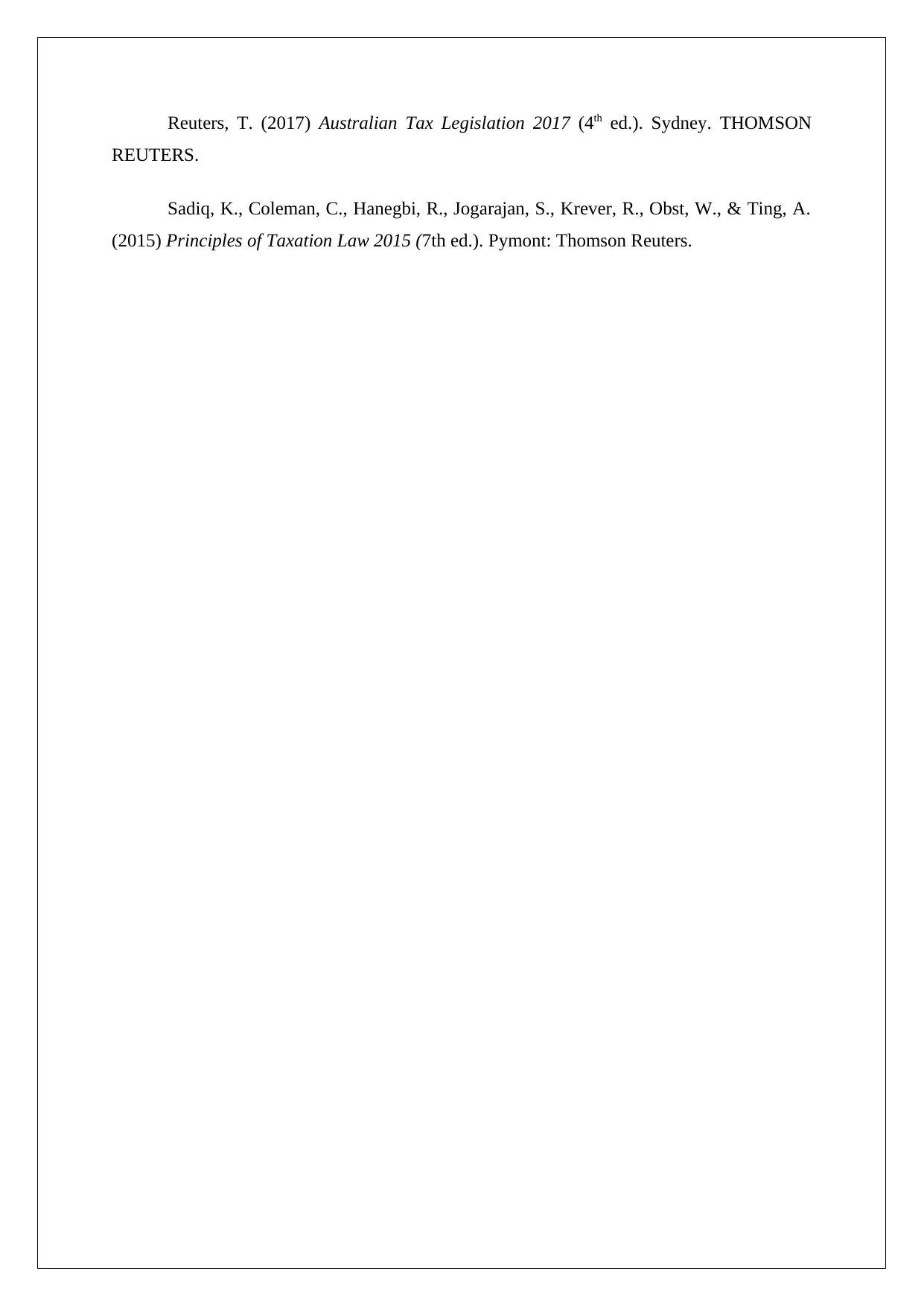
Reuters, T. (2017) Australian Tax Legislation 2017 (4th ed.). Sydney. THOMSON
REUTERS.
Sadiq, K., Coleman, C., Hanegbi, R., Jogarajan, S., Krever, R., Obst, W., & Ting, A.
(2015) Principles of Taxation Law 2015 (7th ed.). Pymont: Thomson Reuters.
REUTERS.
Sadiq, K., Coleman, C., Hanegbi, R., Jogarajan, S., Krever, R., Obst, W., & Ting, A.
(2015) Principles of Taxation Law 2015 (7th ed.). Pymont: Thomson Reuters.
⊘ This is a preview!⊘
Do you want full access?
Subscribe today to unlock all pages.

Trusted by 1+ million students worldwide
1 out of 12
Related Documents
Your All-in-One AI-Powered Toolkit for Academic Success.
+13062052269
info@desklib.com
Available 24*7 on WhatsApp / Email
![[object Object]](/_next/static/media/star-bottom.7253800d.svg)
Unlock your academic potential
Copyright © 2020–2025 A2Z Services. All Rights Reserved. Developed and managed by ZUCOL.




